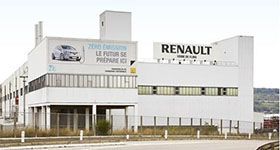.
Renault ZOE electrifies the Flins production plant

Production of ZOE, the flagship of Renault’s electric vehicle range, started at the end of 2012 on the same production lines as New Clio and Clio Collection. The industrial development of ZOE was a tough challenge for Flins, but the plant succeeded in launching the series production of two very different and strategically important vehicles for the company, ZOE and New Clio, at the same site and in the same year. The people at Renault showed outstanding ingenuity to minimize changes to production resources and cope with the specific demands of electric ZOE in the manufacturing process in a totally fluid manner. The production processes of the ZOE and New Clio body shells are so similar that it takes a carefully trained eye to spot the differences between the two.
An almost change-free revolution
The launch of Renault ZOE heralds the start of a new era, in which zero-emission mobility will become broadly affordable. ZOE was designed exclusively for electric propulsion and is crammed with the most advanced electric technology. But its arrival in the plant did not call for that many changes to the means of production. “The arrival of an electric vehicle could have introduced a lot of changes, but we have managed to keep them to a strict minimum,” explains Didier Lehingue, Deputy Director of the plant. That was the goal of the 20-person team tasked with the industrial development of ZOE, headed by David Garreau, when it set to work in June 2009. The team had two years to launch the series production of ZOE on a single line at Flins, while meeting the Brand’s usual standards of quality.
In the first stage, lasting almost one year, the team organized the industrial development process. David Garreau qualifies this phase as “fundamental to defining the basis and finding the optimal industrial organization”. The goal was to find smart solutions, from the design phase through to the production methods, for adapting existing systems and keeping initial outlay under control. For example, the perfectly operational old-generation Acma or ABB robots have been reused. This is called carry-over. After hours of meetings, forecasts and calculations, cost estimates and the development of the end-to-end process, the decisions were finally taken on the technologies and the layout.
Adaptations totally integrated in the manufacturing process
The arrival of ZOE also prompted some larger-scale adaptations. The most radical changes were made in the stamping shop, which produces the opening panels (doors and tailgates). The means of production had to become sufficiently flexible to make opening panels for four different models – ZOE, New Clio, Clio Collection and New Clio RS – instead of just two previously, Clio III and Clio III RS. The white bodies of the RS versions are then shipped to Dieppe, where they are painted and assembled.
Major works to reorganize and refurbish the workshop were organized in the summer breaks in 2011 and 2012, during which the equivalent of one half of a soccer pitch was totally demolished and cleared. The tools were cut at the base by enormous cutting machines and scrapped, and the concrete floors were broken up and rebuilt. The brand new workshop boasts 550 robots, including 150 additional systems for greater flexibility and for performing ZOE-specific welding operations. To score a 5-star rating in EuroNCAP crash tests, ZOE’s chassis was reinforced to protect the battery installed under the floor. On the assembly lines, this means that 500 extra welds are made on ZOE compared with a conventional vehicle.
An extra step has been added at the end of the assembly line, in which the battery is installed in ZOE’s underbody. The production line can switch between Clio Collection and New Clio without making any changes. The three models are manufactured on the same line in a totally fluid manner..
Discover the various stages in the manufacturing of the Renault ZOE in a video
To read the complete press release, please visit Renault's website.
print Tweet




Post new comment